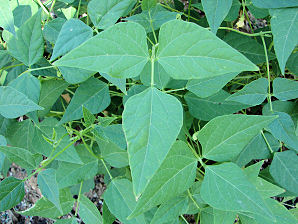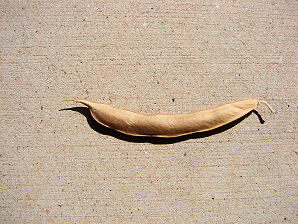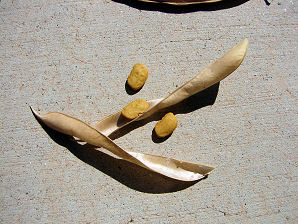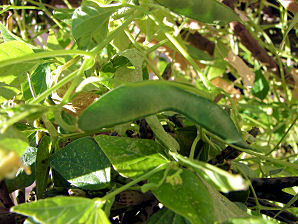Arizona Wild Flowers
Pictures, Photos, Images
Descriptions, Information, Reviews.
Tepary Bean, Phaseolus acutifolius.
We Are Proud Of Our SafeSurf Rating!
Click On Any Of The Following Links By Amazon.Com
For Books, & Videos About Wildflowers Of Arizona & The Southwest USA. No Obligation!
 |
| Tepary Bean, Phaseolus acutifolius. Bush Plant. Some Varieties Are Vines. Photo September 14, 2008. Glendale, Arizona. |
|---|
 |  |
| Tepary Bean, Phaseolus acutifolius. | Tepary Bean, Phaseolus acutifolius. |
|---|---|
 |  |
| Tepary Bean, Phaseolus acutifolius. | Tepary Bean, Phaseolus acutifolius. |
 |  |
| Tepary Bean, Phaseolus acutifolius. | Tepary Bean, Phaseolus acutifolius. |
 /
/

Tepary Bean.
We wish to thank Wikipedia, the free encyclopedia for some of the information on this page. We share images and information with Wikipedia. Tepary Bean or Phaseolus acutifolius is either a vining or a bush plant with edible seeds in a long pod. It is considered an annual, dicot, vine, herb, or forb. It is very drought - hardy and has been cultivated by the Native Americans of the southwestern United States and Mexico for about 2,300 years. It is very sensitive to freezing, flooding, and water-logging. There are over 43 varieties of the genus Phaseolus for sale on todays markets. Five varieties are the most common sold. Tepary bean, (Phaseolus acutifolius L. Gray), is one of the five cultivated species of the genus Phaseolus. It is a native North American legume that has adapted to the southwestern arid and semiarid lands. Thus, it has been considered as a potential food source for the people of African and Middle Eastern regions. Recent studies indicate that the earliest remains of domesticated tepary bean, found in Tehuac�n Valley, Mexico, date from around 2,300 years ago. Phaseolus beans are among the major legumes for food consumption in the world, especially in Latin America, Africa, and Asia. Tepary beans are a traditional food of the Pima, Tohono O'Odham, Hopi and Navajo Indians. It is said that the name tepary may derive from the Tohono O'odham phrase t'pawi or "It's a bean". You may cook tepary beans just like other dry beans, after soaking. Some Native Americans would toast the dry beans, then grind them into a meal mixing them with water before eating. They are high in protein (23-25%). Tepary beans are easily cooked by combining one cup of carefully cleaned and washed beans with three cups of water. Presoaking is not needed. However, we find it makes them softer. Slow cooking yields tender perfectly cooked beans. You can add smoked ham hocks, or bacon at the start if desired. Seasonings like oregano, sage, chili powder, garlic, or onion help out the taste of tepary beans. But, do not add salt at the beginning of your cooking of the beans. The salt will make the beans hard and split the bean skin open. Salt them to taste when they are fully cooked. In Arizona this plant can be planted in April for a June or July harvest. Then be planted again in July for an October or November harvest. It will bloom and become pollinated during the hot and dry Arizona summer climate. It also can be planted in July to take advantage of the Arizona Monsoon rains. It needs moisture to begin growing but is low water use after it gets started. Thus, it is an excellent xeriscape food plant.
Quick Notes:
Height: 1 - 3 feet tall, with a spread of 3 - 4 feet. Vining variety can reach 12 feet in length.
Flowers: White, sometimes pink to light lilac, corolla sometimes creamy-blue to lavender, in axillary racemes. 2�5 flowered. About 1/4 to 1/2 inch in size. Pea Like in apprearance; subequally 5-lobed.
Flowering Time: April - May. Again in July - September.
Seed Pods & Seeds: Short, about 3 inches long, slightly hairy, and green. Later, the pods dry to a light straw color. About five or six beans per pod, vary in color but usually buff colored, flat, resembling a small pinto bean.
Leaves: Leaflets linear to lanceolate, sharply acute, 3 - 8 times as long as broad, rarely or perhaps never lobed, pointed, & pinnately trifoliate.
Found: Native of the USA (AZ, NM, TX). Also found in Northern Mexico in northern Sonora, northern Chihuahua. Cultivated in the Sonoran desert.
Hardiness:
Soil pH requirements:
Sun Exposure:
Elevation: 0 to 6,000 feet.
Habitat: Desert sandy soil, does well in loose soil. Will grow in clay, but not well.
Miscellaneous: Flowering Photos Photo September 14, 2008. Glendale, Arizona. Native to Arizona. An excellent xeriscape food plant.
|



We Are Proud Of Our SafeSurf Rating!
Click On Any Of The Following Links By Amazon.Com
For Books, & Videos About Xerioscape Plants Of Arizona & The Southwest USA. No Obligation!
| © 1966 - Present, Audrey, Eve, & George DeLange |

